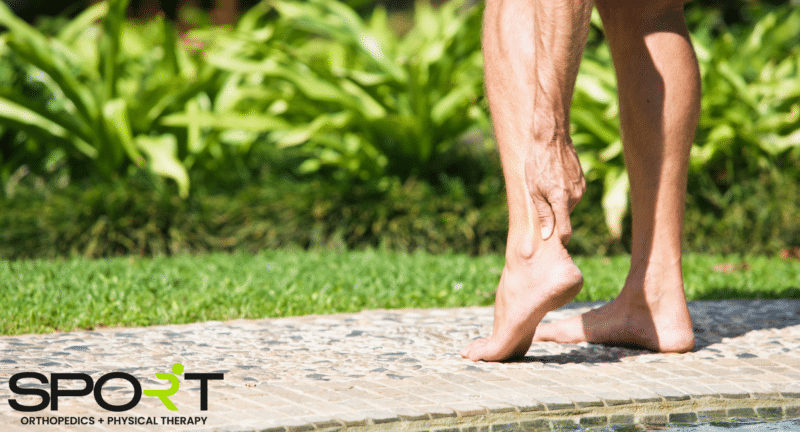Percutaneous Achilles Tendon Repair in Dallas and Frisco
Treatment for Achilles Tendon Rupture, Tendonitis, or Partial Rupture
Percutaneous Achilles Tendon Repair Surgery
Have you ever witnessed a player drop to the floor in agony when watching a basketball game? This could be due to an Achilles tendon injury. This type of injury is common in athletes and people living a physically active lifestyle. Less acute injuries can often heal in as little as a few weeks with physical therapy and other non-invasive therapies. However, more severe injuries may require percutaneous Achilles tendon repair.
The meaning of percutaneous is “affected through the skin.” Percutaneous Achilles tendon repair is a new surgical treatment that is non-invasive and involves less downtime for healing. At SPORT Orthopedics + Physical Therapy, we pride ourselves on being knowledgeable and experienced in the newest and most effective treatment techniques for our clients.
If you’ve suffered an Achilles tendon injury and face the prospect of surgery, percutaneous Achilles tendon repair may be an option for you. Please contact SPORT Orthopedics + Physical Therapy to learn how our Dallas orthopedists and physical therapists can help speed your healing. Call our office today at 469-200-2832 to schedule an appointment. You can also listen to our sports medicine podcast for more information.
What Is the Achilles Tendon?
The band of tissue located in the back of your legs that connects your calf muscle to your heel bone or calcaneus is your Achilles tendon. They are the biggest and strongest tendons in the human body. They average about six inches but can be up to ten inches long and support approximately four times a person’s body weight.
Despite the size and strength of the Achilles tendon, the stress placed on it makes it prone to injury.
Nearly one-quarter of athletes experience an Achilles tendon injury. These injuries often occur during sudden starts or bursts of movement. The tendon also becomes injured over time when stressed repeatedly with high-impact activities. These are called repetitive stress injuries.
However, athletes aren’t the only people who suffer this injury. Falling or jumping from heights or stepping into a hole can cause an Achilles tendon rupture.

Where Is the Achilles Tendon?
Located to the rear of the leg, the Achilles tendon begins mid-calf and ends at the heel. It connects the gastrocnemius and soleus calf muscles in the back of the lower leg to the heel bone.
What Does the Achilles Tendon Do?
The Achilles tendon raises the heel from the ground during movement. Examples of activities that engage the Achilles tendon include:
- Jumping
- Climbing stairs
- Running
- Walking
- Standing on tiptoes
Achilles Tendon Injuries
In addition to athletics and recreational activities, everyday movements place a lot of strain on the Achilles tendons. This tendon is critical to our mobility, and if it becomes swollen or inflamed, it’s called tendonitis.
What Causes Achilles Tendon Injuries?
Achilles tendon injuries occur from sudden or abrupt movements such as jumping, pivoting, or sudden starts or stops. Achilles tendon injuries fall into two categories. These include chronic Achilles tendonitis and acute Achilles rupture.
The suffix “itis” means swelling. So tendonitis is the swelling of the Achilles tendon. However, if the tendon ruptures, it means it tore.
When the Achilles tendon breaks down over time due to age, damage, or overuse, it’s called tendonitis or tendinopathy. Medical professionals use this term when describing severe swelling of the tendon caused by micro-tears.
Tendonitis causes heel pain in the back of the leg and the heel area. Parts of the tendon may thicken and harden from the tendonitis and worsen without treatment.
Tendonitis takes two forms, and they are:
- Non-insertional Achilles tendonitis: This form of tendonitis involves injuries or slight tears to the center of the tendon. The result is pain and inflammation. Primarily younger, active adults are affected.
- Insertional Achilles tendonitis: This occurs where the tendon and heel connect. Bony heel growth or bone spurs often accompany this type of tendonitis. Insertional Achilles tendonitis affects persons at any age, whether they lead an active lifestyle or not.
The micro-tears in your Achilles tendon may eventually lead to a partial or complete tear. When it happens, it may sound like a “pop” coming from the rear of your calf or heel. Typically, a sudden or strong force exerted by the Achilles tendon precedes a rupture.
It often happens during rigorous physical activities, including a burst of speed or pivoting on a foot. A tendon rupture requires immediate medical treatment. You may experience inflammation or pain near the heel. A tear may make it impossible to point your toes.
Who Is Likely to Have an Achilles Tendon Injury?

Achilles tendon injuries happen most often to those aged 30 to 40 years. Men are afflicted with the injury with more frequency than women. Younger well-trained athletes have less risk than older people who don’t train regularly and infrequently engage in high-intensity activity.
However, Achilles tendon injuries are most commonly attributable to sports or recreational activities. Playing basketball is the most common cause of Achilles tendon rupture. Achilles tendon injuries are common in people who do activities where they quickly speed up, slow down, or pivot, such as: running, football, soccer, tennis, and gymnastics.
What Is Achilles Tendon Repair Surgery?
SPORT Orthopedics + Physical Therapy uses the least invasive therapeutic treatments first before turning to surgical options. If this approach isn’t effective, we move to a combination of non-surgical and surgical therapies.
However, your Achilles tendon’s significant injury or tear may require immediate surgical intervention.
There are different types of operations available for correcting Achilles tendon damage. These include:
Chronic Achilles Tendonitis Surgery
- Gastrocnemius Recession: In this procedure, your orthopedic surgeon reduces the tension on the tendon by lengthening the calf muscles.
- Achilles Tendon Debridement: This operation removes damaged parts of the tendon and repairs it with tiny stitches. Bone spurs or other raised areas on the edges of the bone are also removed.
- Tendon Transfer: Partial removal may be the solution when the tendon is too unhealthy or injured. The surgeon transfers the tendon from the big toe to reinforce the damaged tendon.
Ruptured Achilles Tendon Repair Surgery
During the procedure, the orthopedic surgeon makes an incision in the rear of the lower leg and reattaches the torn tendon. It may be necessary to transfer the tendon if the tear is too great.
Percutaneous Achilles Tendon Repair Surgery

There is a non-invasive alternative to an open surgical repair of your damaged Achilles tendon. It’s called percutaneous Achilles tendon surgery. Instead of making one large incision, the orthopedist makes multiple small incisions and sews the two torn pieces of the tendon.
The sutures are made in a crisscross pattern to stitch them together through the tendon. Repairing the tendon this way preserves the healing blood clot that forms around the torn pieces. It also results in a less visible scar.
Benefits of Percutaneous Achilles Tendon Repair Surgery
In addition to preserving the internal healing process and less scarring, percutaneous tendon repair surgery also includes the following perks:
- Less infection risk
- Reduced pain
- Uses local anesthetic and avoids the risks of general anesthesia
- Surgery takes less time
- Healing and rehabilitation progress more quickly
- Most patients may resume playing sports
Recovery from Achilles Tendon Repair Surgery
You may need a walking boot or cast for six to twelve weeks after Achilles tendon surgery. Your orthopedic surgeon will start the cast in a downward position as your tendon heals. Over time, it is adjusted, so your foot moves into a neutral position. You may be given some weight-bearing exercises to work on as well.
Recovery from either an open or percutaneous Achilles tendon repair surgery may take up to six months.
Achilles Tendon Repair Surgery in Dallas

An Achilles tendon injury can be devastating and a season-ender for an athlete. It can take a few months up to a year to recover fully. However, Achilles tendon repair surgery has a high success rate, with more than 80 percent of patients returning to their usual activities and sports. It is best to treat any Achilles tendon injury urgently to avoid further damage for the best results.
Our orthopedic surgeons and physical therapists in Dallas at SPORT Orthopedics + Physical Therapy provide our patients with the highest level of treatment and the latest innovations in injury care. In addition to percutaneous Achilles tendon repair, our highly-skilled staff is knowledgeable in various treatment options ranging from rotator cuff repair and physical therapy to ACL reconstruction and shoulder replacement.
Please contact us today and set up an appointment to discuss your Achilles tendon injury. Our number is (469) 200-2832. Let us help you heal so you can get back to enjoying your life. We have an extensive team of experienced physical therapists, orthopedic surgeons, and physician’s assistants to help you on your journey to recovery.


